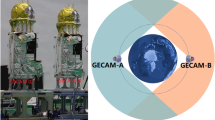Abstract
We use existing light weight balloon facility of Indian Centre for Space Physics to detect the X-ray radiation from Crab pulsar with a phoswich detector. We present the design considerations and characterization of the detector used for this purpose. We model the background radiation in the detector environment at various altitudes and use this in spectral analysis. The background radiation level and limitations on the detector allowed us to calculate minimum detection limit for extrasolar radiation sources with our set up.









Similar content being viewed by others
References
Agostinelli, S., et al.: Geant4 - a simulation toolkit. Nucl. Instr. Methods, A 506, 250–303 (2003)
Bazilevskaya, G.A., Svirzevskaya, A.K.: On the stratospheric measurements of cosmic rays. SpScR 85, 431–521 (1998)
Bhowmick, D., Chakrabarti, S.K., Sarkar, R., Bhattacharya, A., Rao, A.R: Development of Instruments for Space Exploration Using Meteorological-balloons In press JATIS (2019)
Chakrabarti, S.K., Bhowmick, D., Sarkar, R., Mondal, S., Sen, A.: High energy astrophysics with rubber balloons. In: Ouwehand, L. (ed.) Proceedings of European Rocket and Balloon Programmes and Related Research, p 711, 581. ESA SP (2011)
Chakrabarti, S.K., Bhowmick, D., Palit, S., Chakraborty, S., Mondal, S., Bhattacharyya, A., Middya, S., Chakrabarti, S.: A new paradigm in space based experiments using rubber balloons. In: Ouwehand, L. (ed.) Proceedings of European Rocket and Balloon Programmes and Related Research, p 721, 663. ESA SP (2013)
Chakrabarti, S.K., Bhowmick, D., Chakraborty, S., Palit, S.: . Ind. J. Phys. 88, 333 (2014). https://doi.org/1007/s12648-13-0424-z
Chakrabarti, S.K., Bhowmick, D., Sarkar, R., Bhattacharyya, A., Midya, S.: Study of properties of cosmic rays and solar X-ray flares by balloon borne experiments. In: Ouwehand, L. (ed.) Proceedings of European Rocket and Balloon Programmes and Related Research, p 730, 557. ESA SP (2015)
Chakrabarti, S.K., Sarkar, R., Bhowmick, D., Bhattacharya, A.: Study of high energy phenomena from near space using low-cost meteorological balloons. Exp. Astron. 43(3), 311–338 (2017). https://doi.org/10.1007/s10686-017-9540-7
Debnath, D., Nandi, A., Rao, A.R., Malkar, J.P., Hingar, M.K., Kotoch, T.B., Sreekumar, S., Madhav, V.P., Chakrabarti, S.K.: Instruments of RT-2 experiment onboard CORONAS-PHOTON and their test and evaluation I: ground calibration of RT-2/s and RT-2/g. Exp. Astron. 29(1-2), 1–25 (2011)
Gruber, D.E., Blanco, P.R., Heindl, W.A., Pelling, M.R., Rothschild, R.E., Hink, P.L.: The high energy X-ray timing experiment on XTE. A&AS 120, 641–644 (1996)
Kirsch, M.G., et al.: Crab: the standard X-ray candle with all (modern) X-ray satellites. UV, X-Ray, and Gamma-Ray Space Instrumentation for Astronomy XIV. Proceedings of the SPIE 5898, pp 22–33 (2005)
Mizuno, T., Kamae, T., Godfrey, G., Handa, T., Thompson, D.J., Lauben, D., Fukazawa, Y., Ozaki, M.: Cosmic-Ray Background flux model based on a Gamma-Ray large area space telescope balloon flight engineering model. ApJ 614, 1113–1123 (2004)
Peterson, L.E.: Instrumental technique in X-ray astronomy. ARA&A 13, 423–509 (1975)
Picone, J.M., Hedin, A.E., Drob, D.P., Aikin, A.C.: NRL-MSISE-00 Empirical model of the atmosphere: Statistical comparisons and scientific issues. JGR 107, A12,1468 (2002)
Rao, A.R., Malkar, J.P., Hinger, M.K., et al.: Onboard performance of the RT-2 detectors. SoSyR 45(2), 123–134 (2011)
Sarkar, R., Mandal, S., Debnath, D., Kotoch, T.B., Nandi, A., Rao, A.R., Chakrabarti, S.K.: Instruments of RT-2 experiment onboard CORONAS-PHOTON and their test and evaluation IV: background simulations using GEANT-4 toolkit. Exp. Astron. 29(1-2), 85–107 (2011)
Sarkar, R., Chakrabarti, S.K., Pal, P.S., Bhowmick, D., Bhattacharyya, A.: Measurement of secondary cosmic ray intensity at Regener-Pfotzer height using low-cost weather balloons and its correlation with solar activity. AdSpRes 60, 991–998 (2017). https://doi.org/10.1016/j.asr.2017.05.014
Sarkar, R.: Detector Development and Optimization for Space Based Astronomy from Satellites and Balloons. In: Exploring the Universe: From Near Space to Extra-Galactic, Astrophysics and Space Science Proceedings, vol. 53, pp. 371. Springer International Publishing AG, part of Springer Nature (2018)
Staelin, D.H., Reifenstein, III., E.C.: Pulsating radio sources near the crab nebula. Science 162, 1481–1483 (1968)
Thompson, D.J.: A three-dimensional study of 30- to 300-MeV atmospheric gamma rays. J. Geophys. Res. 79, 1309–1320 (1974)
Vadawale, S.V., Chattopadhyay, T., Mithun, N.P.S., et al.: Phase-resolved X-ray polarimetry of the Crab pulsar with the AstroSat CZT Imager. Nature Astron. 2(1), 50–55 (2017)
Vasseur, J., Paul, J., Parlier, B., et al.: Possible Pulsed Gamma Ray Emission above 50 MeV from the Crab Pulsar. Nature 226, 534–535 (1970)
Acknowledgements
The authors would like to thank the ICSP balloon team members, namely, Mr. S. Midya, Mr. H. Roy, Mr. R. C. Das and Mr. U. Sardar for their dedications during the crucial mission operations such as launching and recovery. This work been done under partial financial support from the Science and Engineering Research Board (Science and Engineering Research Board, Department of Science and Technology, Government of India) project no. EMR/2016/003870. We also thank Ministry of Earth Sciences (Government of India) for partial financial support. Grant-in-aid from Department of Higher Education, Government of West Bengal is acknowledged by RS, SKC, DB and AB to carry out the research at ICSP.
Author information
Authors and Affiliations
Corresponding author
Additional information
Publisher’s note
Springer Nature remains neutral with regard to jurisdictional claims in published maps and institutional affiliations.
This work is partially supported by the Science and Engineering Research Board, India grant number EMR/2016/003870
Rights and permissions
About this article
Cite this article
Sarkar, R., Chakrabarti, S.K., Bhowmick, D. et al. Detection of Crab radiation with a meteorological balloon borne phoswich detector. Exp Astron 47, 345–358 (2019). https://doi.org/10.1007/s10686-019-09632-0
Received:
Accepted:
Published:
Issue Date:
DOI: https://doi.org/10.1007/s10686-019-09632-0




